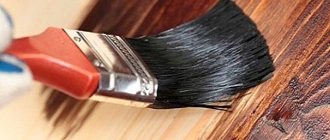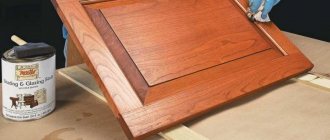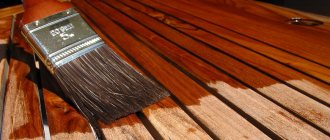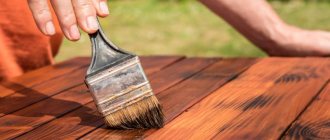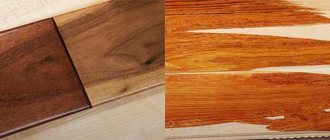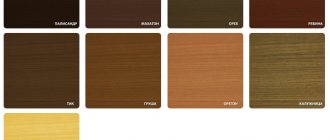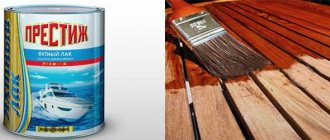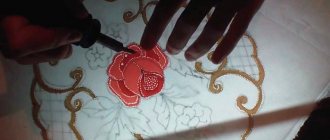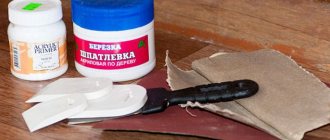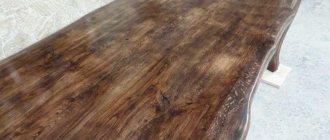Despite the emergence of various innovative materials, wood has been, remains and, most likely, will continue to be in demand in any construction. Well, furniture made from natural wood is considered the most prestigious. The demand for the material is explained by its unsurpassed environmental qualities, natural warmth, durability, and ability to create comfort.
Wood stain
Both in order to maximize the life of products and for decorative purposes, many special means are used, one of which is wood stain. This unique composition can not only transform the appearance of ordinary wood, but also reliably protect its structure from various pests and the effects of external adverse factors.
But to use stain, it is important to be able to understand the variety of possible compositions and the technology for their application.
Calculation of the amount of stain
Before you go to the store to buy stain, calculate how much you need. Each jar displays the consumption of stain, in other words, how many m2 of 1 liter of stain is used.
The value is given within a certain range, but it is always recommended to stick to the lower limit. It may happen that the wood you stain will be too absorbent and therefore the consumption will be higher.
Also keep in mind that you will likely be applying more coats of stain. Thus, if, according to the manufacturer, the spray can is enough for at least 15 m2, and you apply 3 layers of glaze, in fact it will only be enough for 5 m2.
Color spectrum
Beitz is a unique product that helps give wood a noble shade. The structure of the wood is heterogeneous, different areas are impregnated unevenly, therefore, after the composition dries, an original pattern is created on the surface. The most popular shades of stains are included in the wood range; their names correspond to different types of wood. There are also other types of stains on sale: green, black, red, blue and corresponding to other tones that are usually used for painting furniture. If you can’t choose the right color, stains of the same type and brand can be mixed together.
When purchasing, you should carefully consider the samples on which the stains are applied, because the shade on the label and in reality may not match. The finished color will depend on the following factors:
- original wood shade;
- degree of porosity of the material;
- density;
- breed;
- amount of resin.
Deciduous wood is impregnated much better than coniferous wood, so the tone will be as close as possible to the stated one. To give a light shade, you can purchase a lightening impregnation, which also tends to emphasize the wood grain. There are even colorless stains on sale that do not change the color of the wood, but still have full protective properties.
Do you need construction services?
In Ushakov’s Explanatory Dictionary it is said about stain that it is “a caustic liquid with which the surface of the wood being processed is impregnated for the purpose of coloring (in furniture making, pencil making, etc.).” Since our series of articles is devoted to the construction of individual housing and repairs, then “other.” We will pay special attention, leaving the topic of “pencil work” undisclosed.
Stains can be aqueous or non-aqueous. Water-based ones have a wide range of colors and are used to tint any type of wood, as well as to give it various shades. As a rule, wooden surfaces located indoors are covered with this material. Such integral elements of the home as baseboards, trim, door and window blocks, stairs, railings, etc. acquire the color that the home owner chooses at his discretion. If this material is used outdoors, the surfaces treated with it are varnished.
Surfaces coated with water stain are resistant to abrasion. In addition, this material perfectly emphasizes the “pattern” of the tree. In addition to water, water stains contain dyes and aqueous polymers.
This coating can be applied in one or several layers. The main thing is to avoid swelling of the wood. To do this, the surface must be sanded to a perfectly smooth state. After the wood has been sanded, it should be wiped with a damp cloth. After the surface has dried, you need to arm yourself with fine-grained sandpaper and treat the surface with it in order to remove “rising” wood fibers. Only after these “operations” can you begin to apply stain to the base. After applying a layer of this material, it is advisable to wait for it to dry. In this case, it becomes clear whether one or more layers should be applied to achieve the desired effect.
Non-aqueous stain differs from water stain, first of all, in its ability to withstand atmospheric phenomena without the obligatory subsequent application of varnish to the stained surface. However, this ability does not exclude the use of non-aqueous stain indoors. It contains organic solvents, synthetic resins and various dyes. Such coatings can imitate many types of wood: mahogany, larch, oak, walnut and many others. In addition to aesthetic functions, some non-aqueous materials also have a practical function, which is to give the wood non-combustible properties. This coating is used for application to wooden elements of the home - baseboards, trim, etc. This stain absorbs well into the substrate and dries fairly quickly. A brush is used to apply non-aqueous stain. In the case when it becomes clear that the amount of non-aqueous coating applied was clearly overdone, acetone is “connected” to the work. A brush dipped in acetone can remove unwanted material. To do this, the movements of the brush must occur in one direction. In cases where the wood surface to be treated is not static, that is, it does not represent a section of the floor whose position cannot be changed, the workpiece should be placed in an inclined or vertical position and movements with a brush soaked in acetone should be made from top to bottom. Sometimes craftsmen deliberately engage in “provocation” and cover the wood with more stain than is required. They do this so that when they wash off the “excess” material with acetone, they get a more beautiful surface, since it is the wash that gives the wood its magnificent “pattern.”
There are “independent” types of stains. These are chemical and oil-based stains .
There is no dye in the chemical auxiliary materials, but this does not mean that they are not capable of giving the wood the desired color and shade. The fact is that soluble metal salts “act” as dyes for chemical coatings. When these salts interact with wood tannins, the wood becomes colored.
Oil-based stains penetrate deep into the wood and protect it from rotting. They have a huge color palette, but, regardless of color, they preserve and emphasize the “pattern” of the tree. Such materials are used in the production of furniture, and they are also used to cover floors and doors.
One thing is typical for all types of these coatings - they should be applied to clean, grease-free surfaces. To treat wooden surfaces intended for staining, sandpaper, both coarse-grained and fine-grained, is used. Sanding surfaces must be done along the wood fibers. Before covering the wood with a layer of stain, experts advise carrying out some kind of “rehearsal” by taking a small piece of wood and doing the same “operation” with it that you plan to do with a larger surface. It is important that this fragment is made of the same type of wood as the surface that is planned to be covered with stain. You can perform “experiments” with this piece of wood, involving the application of several layers of stain and subsequent coating of this piece with varnish. Using such a fragment as an example, the picture that will appear before you after the completion of the planned “large-scale” work will be clear.
After the “experiment” is considered completed, you can begin staining. Regardless of the type of coating, it is applied to the surface using a brush, roller, swab or spray, but, nevertheless, craftsmen prefer a wide brush. As with sanding, the stain is applied along the grain of the wood. For those who do not have the skills of a specialist in the field of applying this material, there are tampons. With their help, the coating is made uniform and free of smudges.
And lastly, in order to avoid “raising” of wood fibers after applying stain to the surface, as was mentioned in cases with water-based coatings, experts visiting the online magazine DelaySam.ru recommend priming the surface with a solution of liquid glass on water before staining. This will cause the fibers to rise, after which such a “hairy” surface should be sanded. This “procedure” applies not only to aqueous auxiliary materials. Such actions will prevent possible troubles associated with the further appearance of fibers undesirable for the eyes.
This is where we end the series of articles under the general title “Auxiliary Materials,” but the names of the very materials that we got acquainted with in the 33 parts of the article will be spoken by us more than once, since they are all “participants” in construction and repair. But we haven’t said everything about construction and repairs yet. We touched upon the topic of “wood finishing,” but we will talk about this in more detail in one of our future articles.
The next series of articles will be called “Ceiling Coverings”. We are going to get acquainted with different types and types of ceiling coverings. We will try to reveal the secrets of their installation, as well as evaluate specific types of these coatings.
Alexey Kaverau
Photos used in the article: sites ahzvika, ld-keittiot, newporte, vasha-vitrina, , , "SIBLACK"
Manufacturing companies, price and consumer reviews
On the construction market you can find a large selection of manufacturing companies that produce various products, including non-aqueous stains. There are both domestic and foreign brands here. For you, we will consider 2 of the best representatives who are in high demand.
"Novbytkhim"
A company from St. Petersburg that produces and produces stains based on organic solvents and synthetic resins. This composition can be diluted with solvent No. 1. Its advantages include quick drying, absence of wood swelling, and protection of the product from fire. The composition is available in volumes of 0.5, 20 and 200 liters. The product price is about 170 rubles per 1 liter. Buyers give a positive assessment of Novbytkhim non-aqueous stain. They noted the fact that the quality of the composition is high, it dries quickly, the layers are even, and the cost is low. The only downside is the speed of fading in the open air.
Z a r W o o d St a in O il Ba s e d
This is a linseed oil-based stain that is rubbed into a wooden surface like a polish, giving it beautiful shades. Usually, when applying, one layer is enough, because the solution perfectly impregnates the fibers, creating a rigid bond. It prevents moisture from entering. The product price is approximately 1700 per 1 liter. The product has the best reviews - the impregnation dries quickly, fits perfectly, and has virtually no aroma. Buyers did not find any shortcomings, except for the high price.
Dealing with defects
It happens that the stain is applied to the surface incorrectly. Here are the main ways to eliminate defects:
- For numbness. Immediately after tinting the wood, you need to cover the area with varnish, which will dissolve the stain. Then clean the treated area with a rag. When the drip has already dried, it will have to be softened with white spirit or ground off with sandpaper.
- For stains. If we are talking about plywood, you will have to remove all the veneer using a plane. Solid wood is also processed with this tool, removing the thin top layer.
How can I remove stain?
The easiest way to remove water stain from your hands or treated wood. Of course, you can only remove the top layer, because such stains are distinguished by deep penetration. Stained clothes can be washed with regular powder, then rinsed with conditioner. If necessary, use oxygen bleaches, and chlorine bleaches on white items.
If stain gets on linoleum, wipe off the stain with acetone or white spirit. You must work carefully so as not to discolor the surface of the material. You can get rid of stain stains on the skin using vegetable oil or by frequently washing your hands with soap. It is much more difficult to remove non-aqueous types of stains from surfaces; you will have to remove the top layer of wood along with the tinting coating.
How to choose the right wood stain
The choice of stain depends on the type of wood, the conditions of use and the expected result.
When choosing a stain, consider the following factors:
- Place of application of stain . For indoor work, wax or oil stains without volatile compounds are suitable. It is better to work with alcohol impregnations outdoors.
- Density of wood . Wood with a lower density will absorb stain faster. If you use stain to process products made from soft wood, such as pine, poplar, cedar, alder or chestnut, take it with a reserve - the consumption per square meter will be significant.
- Hue . When choosing a stain, consider the final purpose of the treatment - for example, do you want to emphasize some areas of the wood or, conversely, level them out. Also note that the stain should be applied in several layers. The first coat will be lighter than expected as the dyes in the stain are absorbed into the wood.
- Features of chemical reactions of stains . If you are going to treat wood with varnish or polyurethane enamel containing acid, any stain other than wax will suit you. When acid reacts with wax, it can significantly change the shade of the surface.
Recommendations for applying stains
- Before applying stain, sand the surface thoroughly. It is necessary to work with an abrasive material along the grain of the wood; scratches across the grain will be emphasized by the stain and will stand out. The different tone of the stain (different absorbency) will depend on the grain size of the abrasive.
- Before painting an object, it is better to do a test painting. The painting is done on the same material from which the product is made. The result of the surface color is assessed only after complete drying and varnishing, because the color changes significantly.
- When using water-based stains, it is recommended to pre-treat the wood with water. And after drying, sand off the raised pile. Then, after applying water stain, the raising of the pile will be minimized.
- To apply stains to a large, flat surface, it is better to use the widest brush possible.
- It is better to apply the stain liberally and evenly, always along the grain. It is very important to have time to combine wet edges, so with stains, especially alcohol stains, you need to work quickly and without interruptions.
- For a more even application of alcohol stains on large surfaces, you can use a special “Polishing Glaze”, which increases the drying time of the alcohol stain and allows you to spread it over the surface without leaving any traces of joints.
- Since stains are very fluid for processing vertical surfaces and turning products, it is better to use a paint pad, foam rubber or any rag.
Shades
You can find a fairly wide range of non-aqueous stain colors on the market. Most compositions help to imitate expensive types of wood on products made from birch, alder, and pine. Wood stain is especially popular. Shades in demand here include teak, beech, oak, wenge, maple, mocha, walnut and ebony.
Modern compositions make it possible to give wood many other shades. There are almost all the colors of the rainbow here: from yellow to black. The structure of the tree in this case will also be expressed.
But there are compositions that have absolutely no tone. They are designed only to protect the tree from harmful factors such as ultraviolet radiation, moisture, bark beetles and others.
Water stain “Anles”, oak color. - review
Wood stain for 29 rubles. What can she do?
I'm drawing. And I decided to hang some of my works in the apartment, but they had to be framed. The baguette I liked was expensive. The finished frames did not fit. But why not hang my works on pins?!
I like antique classic frames, without gilding. There was no talk of buying an antique frame, but an aged modern frame would be quite suitable. But it also cost a lot of money. And since I can’t afford to buy such a frame, I decided to go a different route. Semi-finished, in the literal sense of the word I ordered half of my future dream frame (i.e. the baguette itself) from a frame shop, and decided to decorate it myself using ordinary stain.
After studying various offers and reading about what it is and how to use it, I went to the store. It didn’t get any easier here, since I was overwhelmed by a huge number of samples, among which there were many beauties. I understood that the color of the sample could (and most likely, will) differ from my real item, since the wood may fit the stain differently, the application technology will be different, and so on and so forth. I chose the water-based stain I liked. To be honest, it cost so little that I thought it wouldn’t paint anything at all.
⚙ Material ⚙
Water stain (oak) is poured into the most ordinary 0.5 liter plastic bottle. and has a coffee color.
